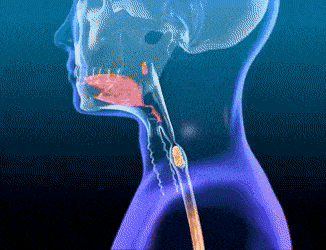And So It Begins: The Mouth and Esophagus
The Mouth
As we discussed previously, the first “organ” of digestion is the mouth: think teeth, tongue, and saliva. Our teeth aren’t just for show; they’re the first step of the mastication (chewing) process that breaks our food down enough to be swallowed and transported (as a bolus) down our gullets (esophagus) to our guts. Our tongue serves to both move our food around to our molars and to taste our food, sending those taste signals to the rest of the body. (Our tongue is actually innervated by our vagus nerve and helps shape the roof of our mouth for better airflow. More on that in later posts.)
Our saliva (yup, spit) is actually pretty amazing. It keeps our mouths wet, which is important for speaking as well as eating. Ever tried eating jerky with a dry mouth? Impossible. Plus, it doesn’t taste like anything without saliva, because our taste buds need moisture to pick up flavors. Researchers have identified over 1,000 proteins in saliva, including enzymes, immune peptides, and secretory IgA (part of our body’s defense system, more on this in the intestines post).
Our saliva contains amylase, an enzyme that breaks down starches, and lysozyme, another enzyme that disintegrates bacteria, preventing tooth decay and other baddies from getting into your digestive tract. Saliva also helps protect our teeth from acidic foods and contains calcium hydroxyapatite (hence new toothpaste products containing it). Saliva also has other proteins and nutrients, which is why we can perform diagnostic salivary testing for cortisol and even estrogen and testosterone. Of note, saliva production is triggered by the autonomic nervous system. Conventional medicine likes to separate our bodies into parts (which really does help for acute, critical medicine), but everything is interconnected.
Saliva is also 99% water, which is why hydration is so critical. I like to think of hydration like taking a daily internal shower. When people ask me, "Does it need to be plain water?" I’ll ask them to envision taking a shower in coffee, soda, or wine. How cleansing does that feel? Things like herbal teas, water with muddled berries or cucumbers, or moderate amounts of sparkling water are better than the former, but plain ol’ H2O is still your best go-to for health.
The next step is the esophagus. Yup, the gullet. The esophagus is the transport tube between the mouth and the stomach with an upper esophageal sphincter (UES) and a lower esophageal sphincter (LES).
What’s a sphincter?
Sphincters are basically ring-like muscles that contract and relax. We have them in many places throughout the body: the esophagus, the cervix, the bladder, and technically even your eyes are sphincters, allowing our pupils to dilate and constrict with light.
The UES controls what we typically think of as swallowing: moving food from our mouths down. This happens through a process called peristalsis or peristaltic movement. Ever seen someone do “the worm” dance move? That’s a bit like what peristalsis looks like, an undulating muscle movement that progresses the food ball (bolus) into the belly.
The LES controls what goes down, stays down. (Except in cases when what goes down must come back up, the esophagus helps us to vomit or burp too.) When it doesn’t function properly, that’s when we get things like heartburn, aka acid reflux, aka GERD. The UES is under voluntary control, while the LES is involuntary, simply responding to the peristaltic presence of a bolus. Interestingly enough, peppermint relaxes the LES, making it more likely to open, while raw almonds and melatonin can help tonify and keep the LES closed. Melatonin slows down digestion, tightening up sphincters along the way. This is part of why it’s advised not to eat too close to bedtime. But inversely, if you’re having trouble with LES, supplementing with melatonin may be helpful. Research suggests melatonin is the body’s homegrown adaptogen.
Continue the Journey
If content like this is your gig, subscribe below, add me to your contacts & follow me on social media for more engaging content on natural and energetic health. I’ll release a new body series post each week. I hope they inspire you to get to know your body and all its functions. I also invite you to ask me your questions on natural and energetic health.



